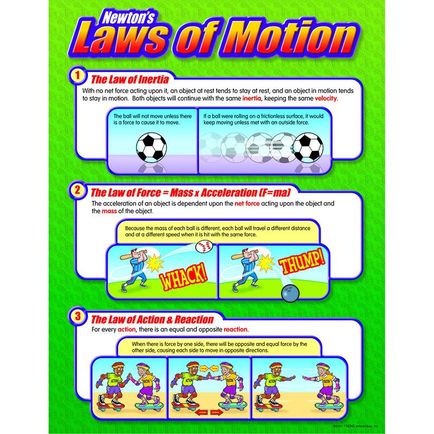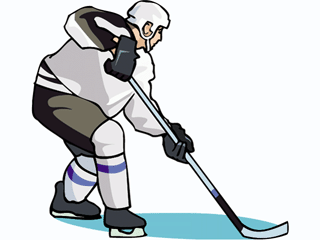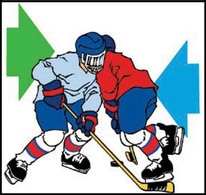Oh, that wan't very helpful. I'll try again! Ice is slippery... Ice hockey is played on ice - which is slippery! Scientists used to think that the pressure on the ice from the skates and the puck caused a film of water to form on top of the ice which made it slippery. However, Professor Gabor Somorjai of the Lawrence Berkeley National Laboratory discovered the skates and pucks don't exert enough pressure to instantly liquefy the ice. Instead, the ice, even the coldest ice, has a natural "quasi-fluid" layer that makes it slippery. Newton's Laws of Motion... Newton's Laws of Motion were published in 1687 and explain how objects move and how those objects react when forces are applied to them. Newton's First Law of Motion..."In Newton's First Law of Motion, objects that are at rest stay at rest and objects in motion stay in motion at a constant speed and in the same direction, unless acted upon by a force. The First Law is also known as the Law of Inertia." (NBCLearn, 1/12)  We all know that if a hockey player is standing still - at rest, the player will stay at rest unless an opposing player checks him, thus putting him in motion. But did you know that a puck moving across the ice would keep moving at that same speed if there weren't any friction acting on it? Newton's Second Law of Motion..."In Newton's Second Law, if an object has an acceleration, that is, a change in velocity, then the net force necessary to cause this acceleration is equal to the mass of the object times the object's acceleration. This law can be written with a simple mathematic formula. F is equal to MA. Force is equal mass time acceleration." (NBCLearn, 1/12)
Newton's Third Law of Motion..."Newton's Third Law of Motion states that for every action there is an equal and opposite reaction" (NBCLearn, 1/12) Lester Holt, an NBC sports reporter explains how Newton's Third Law can also be applied to the 2 players who collide. "Whenever one object applies a force to a second object, the second object applies the same force back to the first object. This can make checking collisions difficult since any force applied to another player is applied back to you" “It’s easy to say to a kid, ‘why do you think you have to swing your arms forward and backward instead of side to side?’ The harder you throw your free arm back, the harder it’s going to throw your motion forward,” says Stamm. “When I explain it that way, then they get it. They know that for every action there’s an equal and opposite reaction.” - Harry Thompson of USA Hockey Magazine Resources for the Science of Hockey...There is so much more to learn about the physics and math and chemistry and biology related to ice hockey! Please check out the links below for more information. NBC Learn has a page on the Science of NHL Hockey with 10 well done videos that relate hockey to vectors, energy, mass and projectile motion. The Exploratorium, a science museum in San Francisco, has a fantastic website that explores all kinds of topics. One section of the website focuses on the science of sports. This is the link to the science of hockey where more information about gear, saves, shooting, checking and fitness can be found.
2 Comments
Grandma
1/24/2017 08:47:26 am
I liked this blog and learned and was reminded of many things. Thanks for all your hard work and I know it is hard work to make these blogs learning experiences, interesting and applicable to real life. Thanks again.
Reply
Kaitie
4/6/2017 12:41:57 am
Sweet! Cool read. Ice is slippery :/ A sports science on rugby would be cool :D
Reply
Your comment will be posted after it is approved.
Leave a Reply. |
Cindy BenedekSharing a little bit of science in our everyday world . Previous Posts
Email to Class Class Pics on Twitter Reliable Blogging Science of Hockey Prof's Boss Adjunct's Classroom Road Salt and Ice Blog Story - Science! Snow - Climate Change Flood in Ellicott City Reindeer, Moose, Musk-ox Oil, Gold, Power Midnight Sun APES Exam Squirrels Ecosphere-Photosynth/Resp Scientific Method/Vaccines Why I Blog View Meteor Shower Iron Age to Van Gogh - Native/Invasive species Forest to Spa Delaware to Germany/Grow Hedges Space-A Vacation/How Planes Fly Snake in my Yard Assasin Bugs/Japanese Beetles Fire Pit Venus Fly Trap Hummingbird Swallowtail Butterflies Classroom Technology Categories
All
Archives
March 2017
Blogs I Follow:
DNA Science Blog Endless Forms Most Beautiful Schlossini Voyage CrestFest Mom's Big Year |
Photos used under Creative Commons from Hampshire Museums, shawncampbell, jfingas




 RSS Feed
RSS Feed
